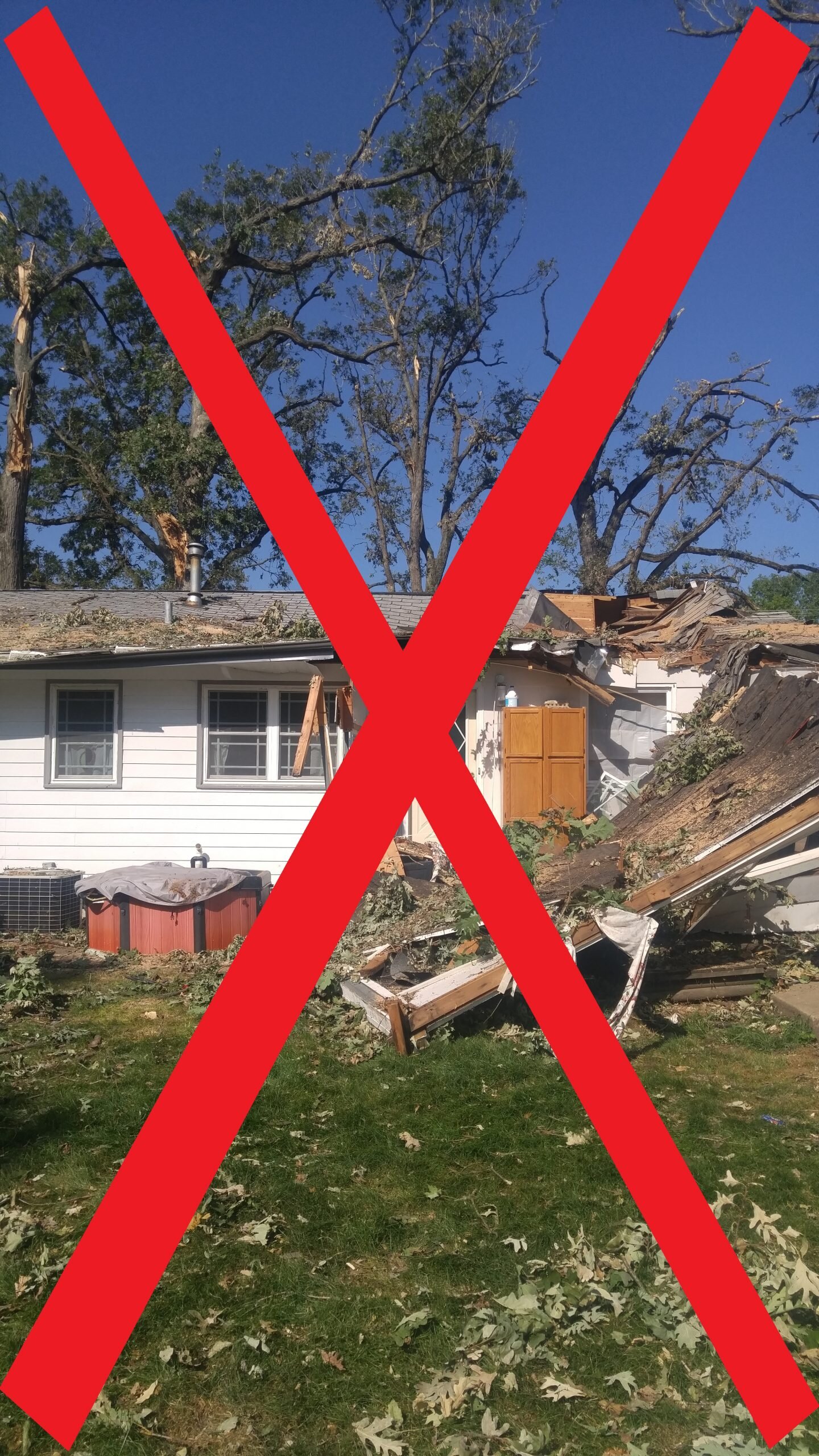capturing phone footage you might actually want to use later
YOU CAN’T ALWAYS PLAN FOR IMPORTANT VIDEO MOMENTS, BUT YOU CAN BE READY WHEN THEY ARRIVE
As I write this my city, Cedar Rapids, Iowa, has just been slammed by a “derecho”, straight-line hurricane-force winds that ripped through our region with no warning. It was an unprecedented disaster. We have tornadoes in Iowa, but we’ve never experienced anything of this magnitude that came so unexpectedly and caused so much damage. Preparation wasn’t possible. In one hour, we lost 50% of our trees. The 110 mph winds blew them over or snapped them off; many onto power lines, houses, cars, or other valuable property.
So many stories will come out of this experience. Powerful moments of devastation, struggle, recovery, and rebuilding will dominate our region’s narrative for the next year at least. I know this because I saw the same thing happen when we were hit with historic major flooding in 2008.
But many of those stories will not be shared through video, because they weren’t captured well when they were happening.
HERE’S HOW YOU CAN MAKE SURE NOT TO LOSE THE MOMENT
Follow these basic guidelines to ensure your footage is usable later on when you have time to edit it together and share it with others.
1. SHOOT IN LANDSCAPE, NOT PORTRAIT
Unless you are specifically capturing footage for something like TikTok or an Instagram story, turn your phone sideways instead of holding it upright. Landscape mode video will be far more useful to you later.
LANDSCAPE
PORTRAIT
2. DON’T MOVE YOUR CAMERA UNLESS ABSOLUTELY NECESSARY!
The biggest mistake people make when using their phones to capture video is they move around, a lot. This leads to shaky, unusable footage which no one wants to watch. Unless you’re a trained videographer who knows how to use intentional camera movement for effect, it’s better to just stand still while recording.
3. COMPOSE YOUR SHOTS
Do you want to stand back and capture the whole scene? Or Do you want to get in close on a saw cutting through wood? Ideally, you’ll get both and more. A combination of close, medium, and wide shots will make your video more interesting later. Rather than just recording 10 minutes of footage from the same angle, a professional videographer might have 10-20 different shots in one minute of footage. You may not have the opportunity in the spur of the moment to get a huge number of shots of an activity playing out before you, but at least try to think of different ways you can see the same scene.
4. RAW CLIPS SHOULD BE AT LEAST 10-15 SECONDS LONG
Anything shorter is probably not going to be usable. Most inexperienced people will take at least the first few seconds of recording to figure out what they’re actually capturing and then compose their shot. Often they stop recording before we’ve had a chance to see anything happen in a well-composed frame. Later, when someone tried to put their footage together, those shorter clips have to be trashed.
At the same time, it’s not helpful to dwell on something too long unless there’s action happening on screen that we absolutely can’t take our eyes off of. Two minutes of footage for something that could have been captured in 15 seconds is just a lot of junk you’ll have to look through later.
5. COMPOSE. RECORD 15-30 SECONDS. STOP. MOVE. REPEAT IN NEW LOCATION.
This is how you’ll get a variety of moments you can put together later as a visual backdrop to someone talking about what happened. That’s how most videos are structured. An interview or voiceover with lots of “b-roll” (non-interview) footage that illustrates what they’re talking about.
6. GET FACES, EYES, HANDS, AND MOTION
People connect with people. We want to see what they’re experiencing. If you can get close enough to capture people’s faces, eyes, and hands, that will probably end up being the most usable footage later on. Make sure you get some clips where these things fill the frame.
Second to that is motion. Since you’re holding your camera still, if you can capture some action taking place that will make your video more interesting.
7. ASK YOURSELF: WHAT DO I NEED TO TELL THIS STORY?
Sometime down the line, you or some editor will be using this footage to help people see and understand what happened during this important moment. Keep that in mind when you’re capturing clips. The most frequent problem editors run into is not enough appropriate footage. Usually it’s that they are left with too few shots and not enough variety to tell the story. So, capture as many different clips as you can using the guidelines above. And then keep asking yourself, what other image could I use to tell this story?
8. ANTICIPATE MOMENTS AND BE THERE TO CAPTURE THEM
Yesterday, a tree care company arrived with a crane and bucket to remove a giant section of an oak tree that had crushed a section of my neighbor’s house. I knew that at some point this crane would hoist the tree from their roof, so I went outside with my camera and tripod to capture the moment. I think I ended up with about 10 clips of various stages in the process. It’s not enough to tell a full story, but if I wanted to later on I could interview my neighbor about their house knowing that when they talk about recovery, I have already captured a key moment in that process.
You can do this with any significant event that happens in your life or the life of your organization. If you know a moment is happening, you (or someone you assign) can use the tips in this article to easily (and cheaply) capture footage for later use.
9. SOUND IS MORE IMPORTANT THAN VIDEO IF YOU’RE FILMING AN INTERVIEW
Interviews will probably come later, when people have time (after the action) to reflect on what happened and tell the story on camera. But sometimes you’ll be in situations where you know you need to capture an interview on the spot. In that case, do everything you can to get decent audio. Good sound is way, way more important than good video.
If all you have is your phone, find as quiet of a place as you can. Then get close to the person you’re filming so your phone’s microphone will get their voice. Get, like, uncomfortably close in a quiet space, if you can manage that without making it totally awkward. If you have a friend with you who also has their phone, let your friend stand back and a little to the side to get a different angle. An interview filmed with two cameras will give an editor the ability to cut the interview down to its best parts without having to use ugly jump cuts if you weren’t able to capture enough b-roll footage.
10. GET WAY MORE THAN YOU THINK YOU’LL NEED
Chances are, you’ll take plenty of bad footage. That’s the nature of documentary video. Even if you’re a trained professional, you will look at your footage later and think, Man, that didn’t turn out like I thought it would. Or, That shot was a waste of time. But if you have 50 different clips for a 1-minute video, you can afford to lose quite a few. Always err on the side of having more footage than you can use.
WHEN TO BRING IN THE PROFESSIONALS
The information in this article will help you save time, energy, and money when it comes to telling important stories through video. But you may not want to do it all yourself. When is the right time to call a professional? Any time you have a question!
Seriously, most videographers are very willing to share advice and help you think through a project. The more we can help you understand the process of making videos, the easier our job is on the day you decide you’d like to hire us to make something special.
Never hesitate to reach out. Chances are we can help you, but if not, we’ll do our best to connect you with someone who can.


